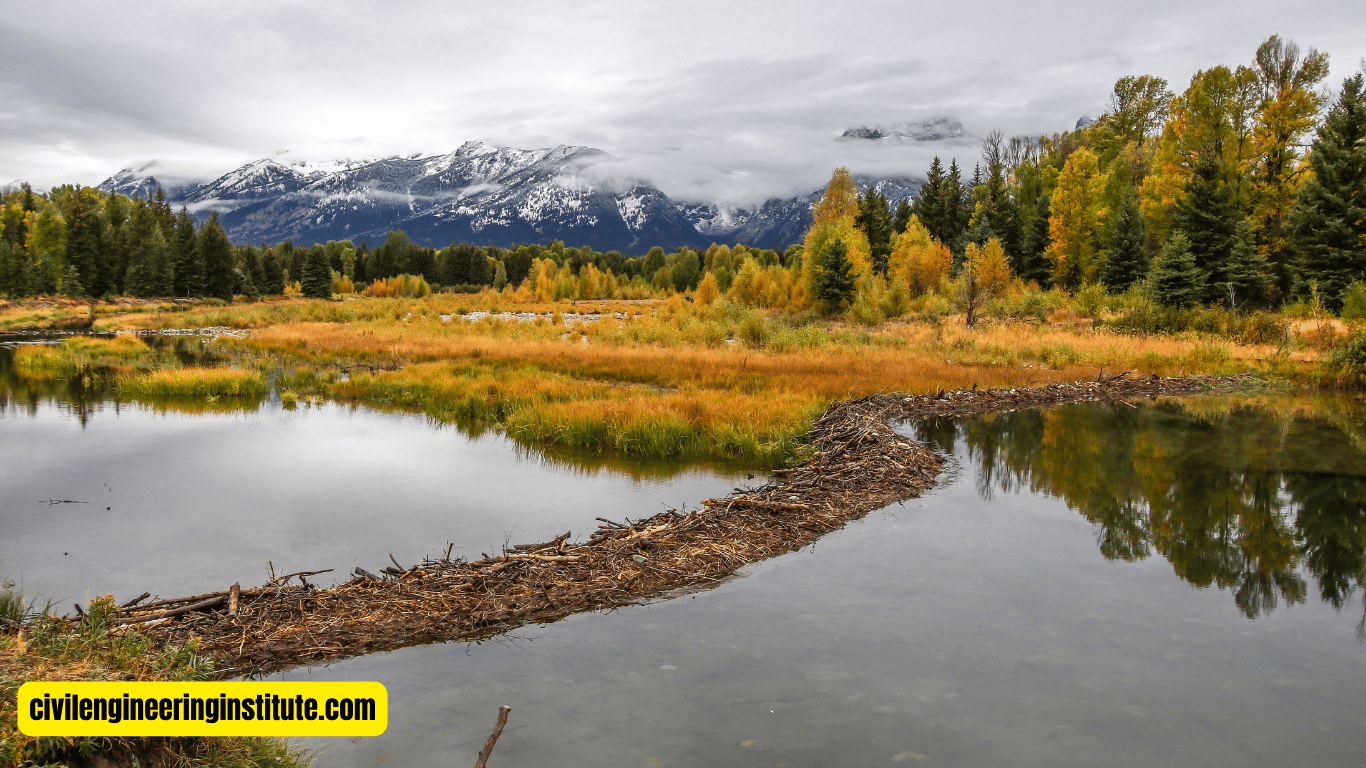This question is commonly asked by people nowadays What is the purpose of a beaver dam? Beaver dams serve an essential purpose in the ecosystem. Beavers use mud, branches, and logs to build these impressive structures. Their main goal is to create ponds or slow-moving streams, which provide habitat for various wildlife and help regulate water flow. By constructing dams, beavers create suitable environments for themselves and other animals, such as fish, birds, and amphibians.
Additionally, these dams can help prevent erosion and filter out pollutants from the water, improving overall water quality. Overall, the purpose of a beaver dam is to support biodiversity, maintain healthy ecosystems, and ensure the availability of resources for both wildlife and humans.
Understanding: What is the purpose of a beaver dam?
Beavers are remarkable creatures known for their engineering prowess in shaping landscapes through the construction of dams. These dams serve a multitude of purposes within the ecosystem, playing a crucial role in maintaining biodiversity and sustaining the health of wetland environments. In this comprehensive guide, we delve into the fascinating world of beaver dams, exploring their purpose, construction, and ecological significance.
What is a Beaver Dam?
Before delving into the purpose of beaver dams, let’s first understand what they are. Beaver dams are structures built by beavers using a combination of materials such as branches, logs, mud, and rocks. These dams are typically constructed across streams and rivers, resulting in the formation of ponds or wetlands. The intricate design of beaver dams allows them to control water flow, creating habitats that support a diverse array of wildlife.
Purpose of Beaver Dams
Beaver dams serve several essential purposes within the ecosystem, each contributing to the overall health and function of wetland environments. Here are some key purposes of beaver dams:
- Habitat Creation
- Water Regulation
- Erosion Control
- Water Filtration
- Climate Regulation
- Nutrient Cycling
Habitat Creation
One of the primary purposes of beaver dams is to create habitats for a wide range of wildlife species. The ponds and wetlands formed by these dams provide shelter, breeding grounds, and food sources for various animals, including fish, amphibians, waterfowl, and mammals. These habitats support diverse ecosystems, promoting biodiversity within the surrounding landscape.
Water Regulation
Beaver dams play a crucial role in regulating water flow within streams and rivers. By slowing down the movement of water, these dams help prevent both floods and droughts. During periods of heavy rainfall, beaver dams absorb excess water, reducing the risk of downstream flooding. Conversely, during dry spells, the stored water behind the dams helps maintain consistent water levels, ensuring a stable environment for aquatic life.
Erosion Control
Another important purpose of beaver dams is erosion control. The intricate network of logs and vegetation within these dams helps stabilize stream banks and prevent soil erosion. By trapping sediment and slowing down water currents, beaver dams promote the deposition of nutrients, which enriches the surrounding soil and supports plant growth. This erosion control function is essential for maintaining the integrity of riparian ecosystems and protecting valuable habitats.
Water Filtration
Beaver dams also act as natural water filtration systems, improving water quality within the ecosystem. As water flows through the dam, sediment and pollutants are trapped, resulting in cleaner and clearer water downstream. This filtration process helps remove contaminants and excess nutrients, mitigating the negative impacts of pollution on aquatic life. In addition to enhancing water quality, beaver dams contribute to the overall health of freshwater ecosystems by maintaining balanced nutrient levels.
Climate Regulation
Beaver dams play a role in climate regulation by influencing the storage and release of carbon within wetland environments. The formation of ponds and wetlands behind these dams promotes the accumulation of organic matter, including plant debris and sediment. This organic material acts as a carbon sink, sequestering carbon dioxide from the atmosphere and storing it within the ecosystem. By maintaining healthy wetland habitats, beaver dams help mitigate climate change by reducing greenhouse gas emissions and preserving carbon stocks in terrestrial landscapes.
Nutrient Cycling
In addition to regulating water quality, beaver dams facilitate nutrient cycling within aquatic ecosystems. The organic matter accumulated behind these dams serves as a nutrient-rich substrate for microbial activity and plant growth. The decomposition of organic material releases essential nutrients such as nitrogen and phosphorus, which are then utilized by aquatic plants and algae. This nutrient cycling process enhances productivity within wetland environments, supporting a thriving community of plants and animals.
Some key points: What is the purpose of a beaver dam?
What Happens If a Beaver Builds a Dam?
When a beaver builds a dam, it creates a barrier across a stream or river using branches, logs, mud, and rocks. This barrier slows down the flow of water, causing it to pool behind the dam and form a pond or wetland. As a result, the landscape is transformed, with new habitats created for various wildlife species. The dam also helps regulate water flow, preventing both floods and droughts downstream. Additionally, the pooling of water behind the dam provides a stable environment for aquatic plants and animals to thrive.
Why Do Beavers Make Dams Sound?
Beavers make dam sounds to communicate with other members of their colony and to mark their territory. The sound of a beaver slapping its tail on the water serves as a warning signal to alert other beavers of potential danger, such as approaching predators. This behavior helps coordinate the activities of the colony and ensures the safety of its members. Additionally, the sound of a beaver making a splash can deter predators and competitors from encroaching on their territory.
How Do You Identify a Beaver Dam?
Identifying a beaver dam is relatively straightforward once you know what to look for. Beaver dams typically appear as large mounds of sticks, branches, and mud across streams or rivers. The dam creates a barrier that causes water to pool behind it, forming a pond or wetland. You may also notice chew marks on nearby trees, indicating the presence of beavers in the area. Additionally, the sound of beavers slapping their tails on the water can be a clue to their presence.
What Are the Benefits of Beaver Dams for the Environment?
Beaver dams provide numerous benefits to the environment. They create habitats for a wide range of wildlife, including fish, amphibians, waterfowl, and mammals. These habitats support biodiversity and promote the health of ecosystems. Beaver dams also help regulate water flow, reducing the risk of floods and droughts downstream. Additionally, they stabilize stream banks, prevent soil erosion, and improve water quality by trapping sediment and pollutants. Overall, beaver dams play a crucial role in maintaining the balance and function of wetland environments.
Why Might It Be Important to Allow Beavers to Build Dams?
Allowing beavers to build dams is important for several reasons. First and foremost, it allows them to fulfill their natural behaviors and contribute to the health of the ecosystem. By creating habitats and regulating water flow, beavers help maintain biodiversity and support the overall functioning of wetland environments. Additionally, allowing beavers to build dams can provide valuable ecosystem services, such as flood control and water filtration. By working with nature rather than against it, we can harness the benefits of beaver activity while minimizing potential conflicts.
Why Do You Think That Beavers Build Dams?
Beavers build dams primarily to create suitable habitats for themselves and other wildlife. By constructing dams across streams and rivers, beavers create ponds and wetlands that provide shelter, food, and breeding grounds for a variety of species. These habitats support a diverse array of plants and animals, contributing to the overall health and resilience of the ecosystem. Additionally, beaver dams help regulate water flow, prevent soil erosion, and improve water quality, further enhancing the benefits they provide to the environment. Overall, the construction of dams is a natural behavior for beavers that serves multiple purposes within the ecosystem.
Conclusion
In conclusion, beaver dams serve a variety of essential purposes within the ecosystem, ranging from habitat creation to water regulation and erosion control. These remarkable structures not only support a diverse array of wildlife but also play a crucial role in maintaining the health and function of wetland environments. By understanding the purpose of beaver dams, we can appreciate the intricate balance of nature and the valuable contributions of these industrious rodents to the natural world.
FAQs
What is a beaver dam?
A beaver dam is a structure that beavers build by obstructing rivers or streams with branches, logs, mud, and rocks to create ponds or wetlands.
Why do beavers build dams?
Beavers build dams to create habitats for themselves and other wildlife, regulate water flow, prevent floods and droughts, and protect their territory.
How do beavers build dams?
Beavers use their sharp teeth to fell trees and gather branches, which they then weave together with mud and rocks to construct a dam across a stream or river.
What animals benefit from beaver dams?
Various animals benefit from beaver dams, including fish, amphibians, waterfowl, and mammals, as they provide shelter, food, and breeding grounds.
Do beaver dams affect water quality?
Yes, beaver dams can improve water quality by trapping sediment and pollutants, resulting in cleaner and clearer water downstream.
Do beaver dams cause flooding?
While beaver dams can sometimes cause localized flooding, they also help regulate water flow and reduce the risk of flooding downstream during heavy rainfall.
How can you identify a beaver dam?
Beaver dams are noticeable as sizable mounds of sticks, branches, and mud across streams or rivers, frequently with chew marks on nearby trees.
Are beaver dams harmful to the environment?
Generally, beaver dams are beneficial to the environment as they create habitats, regulate water flow, and prevent erosion. However, they can occasionally cause conflicts with human infrastructure.
Can beaver dams be removed?
Yes, beaver dams can be removed, but it is important to consider the potential impacts on the surrounding ecosystem and wildlife before doing so.
How can we coexist with beavers and their dams?
Coexisting with beavers involves implementing strategies such as installing flow devices, protecting trees, and maintaining communication with local wildlife authorities to manage potential conflicts effectively.





